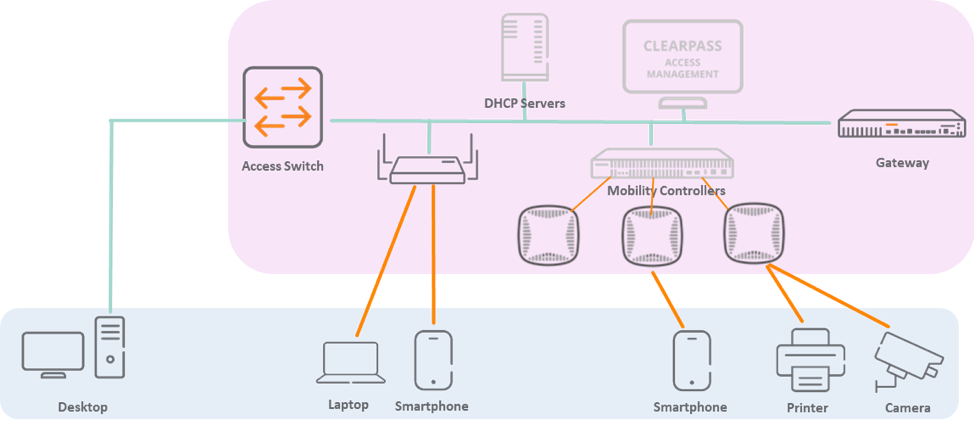Assurance, or performance assurance, is actually two things: It’s a methodology and an outcome. The methodology is a specific, thorough and objective way to measure the performance of your network beyond what has been possible with typical network tools such as network management and monitoring tools. The outcome is that you have the ability to efficiently manage network performance to meet end-user and organizational needs by having an ongoing understanding of the true performance of the end-user’s perspective. The methodology and outcome are vital because you must be able to measure something in order to be able to manage it, and hence assure it.

Figure 1: Typical network management and monitoring tools provide visibility to the components within the purple oval.
A common conundrum network operators and technical support agents face is that the tools they use to monitor and troubleshoot the components of a network reveal that everything is operational. Yet even under such conditions end users will experience problems and submit trouble tickets. Similarly, for solutions that use IoT – the solution is not operating as needed despite network monitors confirming everything is working. This is why you need performance assurance – so you can know whether your network is performing as necessary to support a myriad of use cases that require connectivity between end users, things (IoT), data, services and applications.
Inside Out or Outside In?
While there are several ways to test and assess network performance, there is only one way to do so that is thorough and objective to avert the conundrum just mentioned that arises because typical tools only provide an inside-out perspective. In other words, just looking at network components gives a view from the inside of a network to the end-users and to the cloud. There is tremendous value in this viewpoint. However, it is neither thorough nor objective and therefore needs to be augmented with an outside-in view that truly represents how people experience a network. Actually, the vital view provided is end-to-end through the network or edge-to-cloud.

Figure 2: Performance Assurance tests and assesses network performance from the edge to the cloud.
Testing from the outside-in is the only way to replicate how end users interact with the network. Assessing network performance from outside-in also can cover all wireless access points and all wired topologies. This method is the only way for you to fully understand and assure that experiences are meeting needs and expectations. In other words, to fully test network performance it's necessary to replicate the same interactions end users have with a network – establishing connections, being authenticated and exchanging data. That's a primary function performed by performance assurance sensors.
Sensors such as those included with the Aruba User Experience Insight solution are purpose-built network clients that replicate end-user interactions, capture the corresponding activity and generate metrics. In addition, and unlike sensors from other vendors, Aruba’s sensors are programmable, perform automated troubleshooting and leverage our cloud-hosted analytics to give you a thorough and objective understanding of the performance from points along the edge through the network to public and private clouds.
As an analogy, consider security vulnerability and penetration testing. The only way to truly assess if security measures are blocking unwanted access, traffic and malicious activity is to try defeat security measures from the outside-in, so you can objectively know if your security measures are operating collectively and holistically as needed. This same principal applies to performance assurance.
Network Independence
Performance assurance should be implemented independent from your network because:
- You cannot rely on a network that's having a problem to definitively and objectively convey that it is having a problem.
- It can readily provide its benefits even if your network includes (or may include) non-Aruba components, or components from more than one vendor.
Interoperability
Insights from an independent assurance solution augment traditional network management and monitoring tools, so it is ideal for the insights to be available to other solutions to provide unified visibility, alarms/alerts and troubleshooting. Insights from Aruba’s solution will soon be available via an API. Aruba uses this API to bring the insights into Aruba Central, making it a truly unified network operations, assurance and security platform. Aruba’s customers and third parties will be able to use the API to extend the capabilities of their systems and solutions too.
Summary
Network monitoring and network management historically answers these questions:
- What is the status of each component of my network?
- What is the overall status of my network?
- What devices are connected and what traffic are they generating?
- What is the topology?
Performance assurance also answers the first two questions above, and augments your understanding and effectiveness by providing an answer to this question:
- What is actual performance experienced by end-users, their client devices and IoT devices using my network?
I hope this information helps you appreciate that end-user experience insights are vital to efficiently manage a network and why a network-independent performance assurance solution such as Aruba User Experience Insight must be an integral part of your network operations methodologies.
Related Content
Learn more about Aruba's new approach to analytics and assurance.




